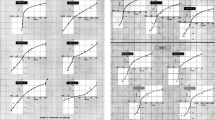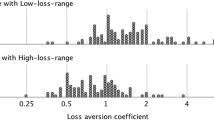Abstract
This paper investigates the shape of the utility function for losses. From a rational point of view it can be argued that utility should be concave. Empirically, measurements of the utility for losses show mixed results but most evidence supports convex rather than concave utilities. However, these measurements use methods that are either biased by the certainty effect or require complex parametrical estimations. This paper re-examines utility for losses, avoiding the mentioned pitfalls by using the tradeoff method. We find that utility for losses is convex. This is contrary to common assumption in the economics literature. Also, we investigate properties of the tradeoff method showing a new violation of procedure invariance. Our findings demonstrate that diminishing sensitivity is an important phenomenon for utility elicitation.
Similar content being viewed by others
References
Abdellaoui, Mohammed. (March 1998). “Parameter-Free Elicitation of Utilities and Probability Weighting Functions,” ENS de Cachan, Department of Economics and Management, working paper.
Allais, Maurice. (1953). “Le Comportement de l'Homme Rationnel devant le Risque: Critique des Postulats ex Axiomes de l'Ecole Américaine,” Econometrica 21, 503-546.
Baron, Jonathan. (1997). “Confusion of Relative and Absolute Risk in Valuation,” Journal of Risk and Uncertainty 14, 301-309.
Beattie, Jean & Graham Loomes. (1997). “The Impact of Incentives upon Risky Choice Experiments,” Journal of Risk and Uncertainty 14, 155-168.
Bentham, Jeremy. (1789). Principles of Morals and Legislation. At the Clarendom Press, Oxford.
Bernoulli, Daniel. (1738). “Specimen Theoria Novae de Mensura Sortis,” Commentarii Academiae Scientiarum Imperialis Petropolitanae 5, 175-192. Translated to English by Louise Sommer (1954), “Exposition of a New Theory on the Measurement of Risk,” Econometrica 22, 23-36.
Camerer, Colin F. (1995). “Individual Decision Making,” in John H. Kagel & Alvin E. Roth (Eds.), Handbook of Experimental Economics. Princeton University Press, Princeton, NJ, 587-703.
Camerer, Colin F. and Teck-Hua Ho. (1994). “Violations of the Betweenness Axiom and Nonlinearity in Probability,” Journal of Risk and Uncertainty 8, 167-196.
Cramer, Gabriel. (1728). Letter from Cramer to Nicholas Bernoulli. Translated into English by Louise Sommer in Bernoulli, Daniel (1954), “Exposition of a New Theory on the Measurement of Risk,” Econometrica 22, 23-36.
Cohn, Richard A., Wilbur G. Lewellen, Ronald C. Lease, & Garv G. Schlarbaum. (1975). “Individual Investor Risk Aversion and Investment Portfolio Composition,” Journal of Finance 30, 605-620.
Currim, Imran S. & Rakesh K. Sarin. (1984). “A Comparative Evaluation of Multiattribute Consumer Preference Models,” Management Science 30, 543-561.
Davidson, Donald, Patrick Suppes, & Sidney Siegel. (1957). “Decision Making: An Experimental Approach,” Stanford University Press, Stanford; Chapter 2 has been reprinted in Ward Edwards & Amos Tversky (1967, Eds.), Decision Making. Penguin, Harmondsworth, 170-207.
Delquié, Philippe. (1993). “Inconsistent Trade-Offs between Attributes: New Evidence in Preference Assessment Biases,” Management Science 39, 1382-1395.
Dyer, James S. & Rakesh K. Sarin. (1982). “Relative Risk Aversion,” Management Science 28, 875-886.
Edwards, Ward. (1954). “The Theory of Decision Making,” Psycological Bulletin 51, 380-417.
Edwards, Ward. (1962). “Subjective Probabilities Inferred from Decisions,” Psychological Review 69, 109-135.
Erev, Ido & Thomas S. Wallsten. (1993). “The Effect of Explicit Probabilities,” Journal of Behavioral Decision Making 6, 221-241.
Farquhar, Peter H. (1984). “Utility Assessment Methods,” Management Science 30, 1283-1300.
Fischhoff, Baruch, Paul Slovic, & Sarah Lichtenstein. (1980). “Knowing What You Want: Measuring Labile Values,” in Thomas Wallsten (Ed.), Cognitive Processes in Choice and Decision Behavior. Erlbaum, Hillsdale NJ, Chapter 7, 119-141.
Fishburn, Peter C. & Gary A. Kochenberger. (1979). “Two-Piece von Neumann-Morgenstern Utility Functions,” Decision Sciences 10, 503-518.
Friend, Irwin & Marshall E. Blume. (1975). “The Demand for Risky Assets,” American Economic Review 65, 900-922.
Galanter, Eugene. (1980). “Utility Functions for Nonmonetary Events,” American Journal of Psychology 103, 449-470.
Gonzalez, Richard & George Wu. (1998). “On the Form of the Probability Weighting Function,” in preparation.
Green, Paul E. (1963). “Risk Attitudes and Chemical Investment Decisions,” Chemical Engineering Progress 59, 35-40.
Hershey, John C., Howard C. Kunreuther, & Paul J.H. Schoemaker. (1982). “Sources of Bias in Assessment Procedures for Utility Functions,” Management Science 28, 936-953.
Hershey, John C. & Paul J.H. Schoemaker. (1985). “Probability versus Certainty Equivalence Methods in Utility Measurement: Are They Equivalent?” Management Science 31, 1213-1231.
Johnson, Eric & David Schkade. (1989). “Bias in Utility Assessments: Further Evidence and Explanations,” Management Science 35, 406-424.
Kahneman, Daniel & Amos Tversky. (1979). “Prospect Theory: An Analysis of Decision under Risk,” Econometrica 47, 263-291.
Laughhunn, Dan J., John W. Payne, & Roy Crum. (1980). “Managerial Risk Preferences for Below-Target Returns,” Management Science 26, 1238-1249.
Libby, Robert & Peter C. Fishburn. (1977). “Behavioral Models of Risk Taking in Business Decisions: A Survey and Evaluation,” Journal of Accounting Research 15, 272-292.
Lichtenstein, Sarah & Paul Slovic. (1971). “Reversals of Preference between Bids and Choices in Gambling Decisions,” Journal of Experimental Psychology 89, 46-55.
Luce, R. Duncan & Peter C. Fishburn. (1991). “Rank-and Sign-Dependent Linear Utility Models for Finite First-Order Gambles,” Journal of Risk and Uncertainty 4, 29-59.
Markowitz, Harry M. (1952). “The Utility of Wealth,” Journal of Political Economy 60, 151-158.
Marshall, Alfred. (1920). Principles of Economics. 8th edition 1948, 9th edition 1961, MacMillan, New York.
McCord, Mark & Richard de Neufville. (1986). “'Lottery Equivalents': Reduction of the Certainty Effect Problem in Utility Assessment,” Management Science 32, 56-60.
Officer, Robert R. & Albert N. Halter. (1968). “Utility Analysis in a Practical Setting,” American Journal of Agricultural Economics 50, 257-277.
Parker, Scott & Bruce Schneider. (1988). “Conjoint Scaling of the Utility of Money Using Paired Comparisons,” Social Science Research 17, 277-286.
Pratt, John W. (1964). “Risk Aversion in the Small and in the Large,” Econometrica 32, 122-136.
Quattrone, George A. & Amos Tversky. (1988). “Contrasting Rational and Psychological Analyses of Political Choice,” American Political Science Review 82, 719-736.
Quiggin, John. (1982). “A Theory of Anticipated Utility,” Journal of Economic Behaviour and Organization 3, 323-343.
Samuelson, Paul A. (1937). “A Note on Measurement of Utility,” Review of Economic Studies 4 (issue 2, February 1937), 155-161.
Savage, Leonard J. (1954). The Foundations of Statistics. Wiley, New York. (Second edition 1972, Dover, New York).
Smidts, A. (1997). “The Relationship between Risk Attitude and Strength of Preference: A Test of Intrinsic Risk Attitude,” Management Science 43, 357-370.
Slovic, Paul & Sarah Lichtenstein. (1983). “Preference Reversal: A Broader Perspective,” American Economic Review 73, 596-605.
Starmer, Chris & Robert Sugden. (1989). “Violations of the Independence Axiom in Common Ratio Problems: An Experimental Test of Some Competing Hypotheses,” Annals of Operations Research 19, 79-101.
Swalm, Ralph O. (1966). “Utility Theory. Insights into Risk Taking,” Harvard Business Review 47, 123-136.
Stigler, George L. (1950). “The Development of Utility Theory: I; II,” Journal of Political Economy 58, 307-327; 373-396. Reprinted in Alfred N. Page (1968), Utility Theory: A Book of Readings. Wiley, New York, 55-119.
Szpiro, George G. (1986). “Measuring Risk Aversion: An Alternative Approach,” Review of Economics and Statistics 68, 156-159.
Thaler, Richard H. & Eric Johnson. (1990). “Gambling with the House Money and Trying to Break Even: The Effects of Prior Outcomes on Risky Choice,” Management Science 36, 643-660.
Tversky, Amos & Daniel Kahneman. (1974). “Judgment under Uncertainty: Heuristics and Biases,” Science 185, 1124-1131.
Tversky, Amos & Daniel Kahneman. (1992). “Advances in Prospect Theory: Cumulative Representation of Uncertainty,” Journal of Risk and Uncertainty 5, 297-323.
Tversky, Amos, Paul Slovic & Daniel Kahneman. (1990). “The Causes of Preference Reversal,” American Economic Review 80, 204-217.
Viscusi, W. Kip. (1989). “Prospective Reference Theory: Toward an Explanation of the Paradoxes,” Journal of Risk and Uncertainty 2, 235-264.
von Neumann, John & Oskar Morgenstern. (1944). Theory of Games and Economic Behavior. Princeton University Press, Princeton NJ.
Wakker, Peter P. (1994). “Separating Marginal Utility and Probabilistic Risk Aversion,” Theory and Decision 36, 1-44.
Wakker, Peter P. & Daniel Deneffe. (1996). “Eliciting von Neumann-Morgenstern Utilities when Probabilities Are Distorted or Unknown,” Management Science 42, 1131-1150.
Wolf, Charles & Larry Pohlman. (1983). “The Recovery of Risk Preferences from Actual Choices,” Econometrica 51, 843-850.
Wu, George & Richard Gonzalez. (1996). “Curvature of the Probability Weighting Function,” Management Science 42, 1676-1690.
Author information
Authors and Affiliations
Rights and permissions
About this article
Cite this article
FENNEMA, H., VAN ASSEN, M. Measuring the Utility of Losses by Means of the Tradeoff Method. Journal of Risk and Uncertainty 17, 277–296 (1998). https://doi.org/10.1023/A:1007739018615
Issue Date:
DOI: https://doi.org/10.1023/A:1007739018615




